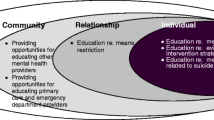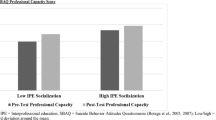Abstract
Objective
A high percentage of suicide victims have seen a primary care physician in the months before committing suicide. Thus, primary care physicians may play an important role in suicide prevention.
Method
The authors mailed a survey to directors of training programs in family practice, internal medicine, and pediatrics, and 50.5% responded. Data obtained were analyzed with WebStat.
Results
Training directors reported deficiencies in training in suicide and depression. Notably, less than half of the internal medicine and pediatrics training directors who replied reported that teaching about suicide was adequate. The majority of them indicated a need for standardized curricular materials on suicide and depression.
Conclusions
Experts could provide standardized curricula to primary care residencies in the recognition and management of suicide and depression. More robust training about these vital mental health concerns in primary care could reduce morbidity and mortality.
Similar content being viewed by others
References
King E: Suicide in the mentally ill: an epidemiological sample and implications for clinicians. Br J Psychiatry 1994; 165: 658–663
Barraclough B, Bunch J, Nelson B, Sainsbury P, et al: A hundred cases of suicide: clinical aspects. Br J Psychiatry 1974; 125: 355–373
Luoma JB, Martin CE, Pearson JL: Contact with mental health and primary care providers before suicide: a review of the evidence. Am J Psychiatry 2002; 159: 909–916
Young AS, Klap R, Sherbourne CD, Wells KB, et al: The quality of care for depressive and anxiety disorders in the united states. Arch Gen Psychiatry 2001; 58: 55–61
Hirschfeld RMA, Keller MB, Panico S, et al: The national depressive and manic-depressive association consensus statement on the undertreatment of depression. J Am Med Assoc 1997; 277: 333–340
Perez-Stable EJ, Miranda J, Munoz RF, et al: Depression in medical outpatients: underrecognition and misdiagnosis. Arch Intern Med 1990; 150: 1083–1088
Capriotti T: Unrecognized depression in the elderly: a nursing assessment challenge. Medsurgical Nurs 1995; 1995; 4: 47–54
Medow MA, Borowsky SJ, Dysken S, et al: Internal medical residents’ ability to diagnose and characterize major depression. Western J Med 1999; 170: 35–40
Davidson JR, Meltzer-Brody SE: The underrecognition and undertreatment of depression: what is the breadth and depth of the problem? J Clin Psychiatry 1999; 60(suppl 7): 4–9
Parchman ML: Physicians’ recognition of depression. Fam Pract Res J 1992; 12: 431–438
von Ammon Cavanaugh S, Kennedy S: A successful psychiatric training program for medical residents. General Hosp Psychiatry 1986; 8: 73–79
Kick SD: An educational intervention using the agency for health care policy and research depression guidelines among internal medicine residents. Int J Psychiatry Med 1999; 29: 47–61
Hodges B, Inch C, Silver I: Improving the psychiatric knowledge, skills and attitudes of primary care physicians, 1950–2000: a review. Am J Psychiatry 2001; 158: 1579–1586
Bongar B, Harmatz M: Clinical psychology graduate education in the study of suicide: availability, resources, and importance. Suicide Life Threat Behav 1991; 21: 231–244
Bongar B, Harmatz M: Graduate training in clinical psychology and the study of suicide. Professional Psychol Res Pract 1989; 20: 209–213
Weissberg M: The meagerness of physicians’ training in emergency psychiatric intervention. Academic Med 1990; 65: 747–750
Boris NW, Fritz GK: Pediatric residents’ experiences with suicidal patients: implications for training. Acad Psychiatry 1998; 22: 21–28
Ebbage J, Farr C, Skinner DV, et al: The psychosocial assessment of patients discharged from accident and emergency departments after deliberate self-poisoning. J Royal Soc Med 1994; 87: 515–516
Marcell AV, Klein JD, Fischer I, et al: Male adolescent use of health care services: where are the boys? J Adolesc Health 2002; 30: 35–43
Ziv A, Boulet JR, Slap, GB: Utilization of physician offices by adolescents in the United States. Pediatrics 1999; 104: 35–42
Sliman RJ, Donohue TA, Jarjoura D, et al: Recognition of depression by internal medicine residents. J Community Health 1992; 17: 143–152
Moore JT, Silimperi DR, Bobula JA: Recognition of depression by family medicine residents: the impact of screening. J Fam Pract 1978; 7: 509–513
Accreditation Council for Graduate Medical Education. (2000). Program requirements currently in effect. http://www.acgme.org.
Gaynes BN, West SL, Ford CA, et al: Screening for suicide risk in adults: a summary of the evidence for the U.S. Preventive Services Task Force. Ann Intern Med 2004; 140: 822–835
Ellis T, Dickey T, Jones E: Patient suicide in psychiatry residency programs: a national survey of training and postvention practicers. Acad Psychiatry 1998; 22: 181–189
Author information
Authors and Affiliations
Corresponding author
Additional information
The authors thank Drs. Ellis and Dickey for sending us a copy of a questionnaire that they developed to survey suicide postvention in training programs (25).
Rights and permissions
About this article
Cite this article
Sudak, D., Roy, A., Sudak, H. et al. Deficiencies in Suicide Training in Primary Care Specialties: A Survey of Training Directors. Acad Psychiatry 31, 345–349 (2007). https://doi.org/10.1176/appi.ap.31.5.345
Received:
Revised:
Accepted:
Published:
Issue Date:
DOI: https://doi.org/10.1176/appi.ap.31.5.345




